Trolling For Salmon: A Complete How-To Guide To DIY
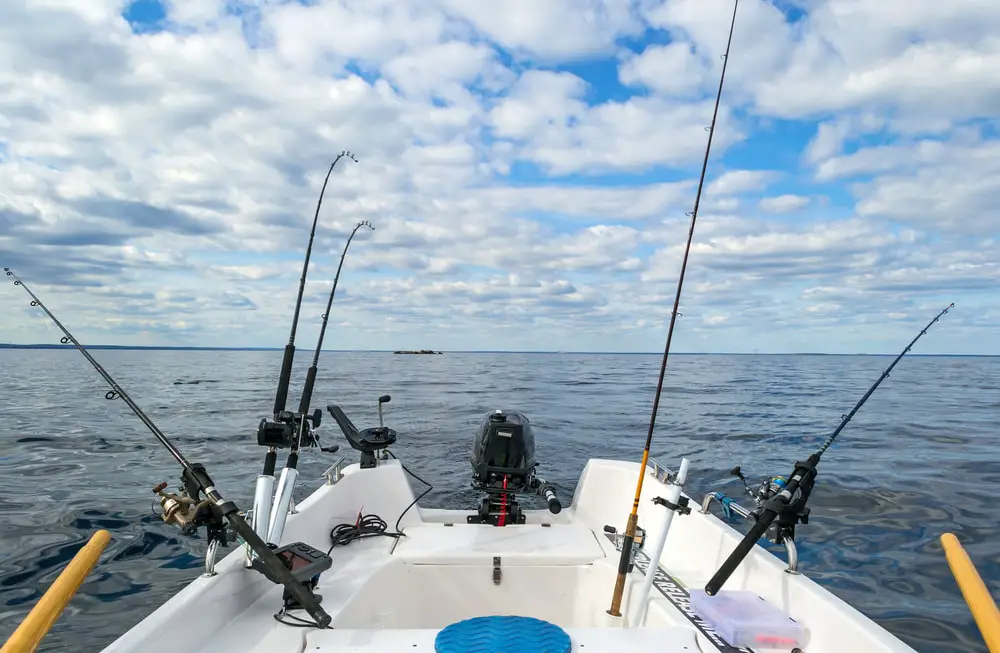
Trolling for Salmon is a thrilling angling adventure that allows you to explore vast waterbodies in search of these prized fish. Whether you’re targeting Chinook, fishing for Coho, Atlantic, or any other Salmon species, trolling allows you to cover water fast, cover multiple depths, and troll multiple lures.
By understanding the different Salmon species, mastering trolling techniques, and choosing the right equipment, trolling can maximize your chances of a successful salmon fishing trip.
In this comprehensive guide on catching salmon while trolling, I will explore the different Salmon species and the best lures for each, top trolling spots, speed, depth, gear, and best times of the year.
The Salmon Species You Can Troll For
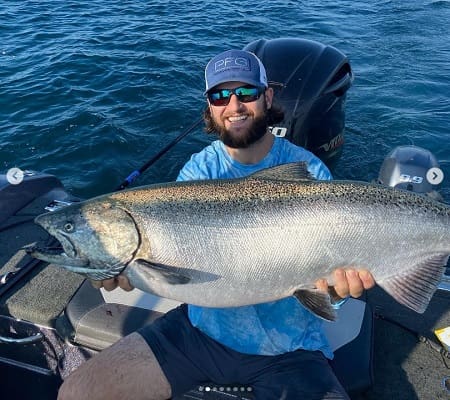
Whether you’re trying to catch salmon in the Pacific Ocean or the Great Lakes, if you want to catch more fish, you need to know the available species.
Let’s take a closer look at the Salmon species you can target while trolling:
- Chinook Salmon: Also known as King Salmon, it is the largest species of Pacific Salmon, and it can reach weights exceeding 50 pounds, providing anglers with an exhilarating challenge. See King Salmon Fishing.
- Coho Salmon: Coho, also called Silver Salmon, may not grow as large as Chinook, but they compensate with their remarkable acrobatics and tenacity. Pound for pound, Coho are known for their ferocious fighting spirit, making them a favorite target for many anglers.
- Sockeye Salmon: Sockeye, or Red Salmon, is highly regarded for its deep-red flesh and delicious taste, but trolling for Sockeye is not as common due to their feeding behavior.
- Pink Salmon: Pink Salmon, also known as Humpies or just Pinks, is the smallest of the Pacific Salmon species. While they might not match the size of their larger cousins, Pinks make up for it with their sheer numbers and abundant availability. They offer fantastic action for novice anglers and those looking for a fun-filled fishing experience.
- Chum Salmon: Chum Salmon, also called Dog Salmon, are known for their distinctive spawning colors and aggressive nature. While they may not be as sought after for their table fare, they provide excellent sport fishing opportunities and can be targeted while trolling.
- Atlantic Salmon: Atlantic Salmon is native to the North Atlantic Ocean but has been introduced to various regions worldwide. These prized game fish are known for their incredible leaping ability and challenging fights. Trolling for Atlantic Salmon can be a thrilling adventure, especially in rivers and estuaries.
Why Trolling For Salmon?
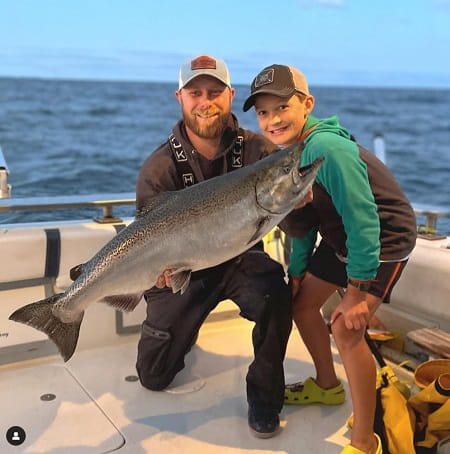
Trolling involves dragging trolling rigs, also known as a hooked lure or bait through the water from a moving boat.
Salmon trolling allows anglers to cover a substantial amount of water, which increases the chances of enticing salmon to strike.
Here are some compelling reasons why guides and I troll for Salmon:
- Versatility: Trolling offers exceptional versatility, allowing the angler to explore different depths and cover a wide range of fishing areas. By trolling, I can target various Salmon species, adapt to different water conditions, and increase my chances of success.
- Maximum Coverage: Trolling enables me to cover a large expanse of water compared to other fishing techniques. Instead of staying in one spot and waiting for the fish to come to me, trolling allows me to actively search for Salmon. This mobility increases my chances of encountering feeding or migrating fish and increases my overall catch rate.
- Multi-Line Fishing: One of the advantages of trolling is the ability to fish with multiple lines simultaneously. With multiple lines in the water, I can present a variety of lures or baits at different depths and increase the chances of a bite. This strategy helps me determine the preferred bait or presentation style for the Salmon on that particular day.
- Targeting Deep-water Hideouts: Salmon are known to be solitary creatures, except when they form schools in the ocean. Trolling allows me to target their hideouts, especially in deep and vast bodies of water. By exploring different depths and using downriggers, I can present your bait or lure at the precise level where the Salmon are holding, increasing your chances of enticing a strike.
- Bait Variation: Trolling gives me the freedom to experiment with different baits and lures. If one type of bait or lure is not attracting the Salmon, I can easily switch to another option without disrupting my fishing setup. This flexibility allows me to adapt to the changing preferences of the fish and increase the chances of success.
How To Troll for Salmon
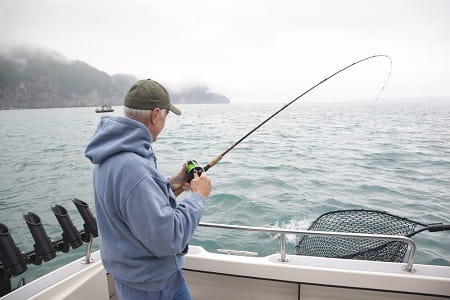
Now that you understand the benefits, let’s explore the steps involved in preparing for a successful trolling adventure:
Section 1: Choosing the Right Equipment
Trolling requires specific gear to ensure optimal performance, the perfect setup, and a successful fishing trip. Here’s a breakdown of the essential equipment I use:
- Fishing Rods: Opt for trolling rods that are specifically designed for this angling technique. Trolling rods are generally longer, ranging from 9 to 12 feet, allowing me to spread the lines farther from the boat. Choose rods with varying action and power, such as medium-light, medium-heavy, and heavy medium-to-fast action, to accommodate different fishing conditions and Salmon species. Consider the Lamiglas XCC Kwik Series Salmon & Steelhead Rod.
- Reels: Select line-counter trolling reels that can handle the demanding nature of Salmon fishing. Trolling reels should have a smooth drag system and sufficient line capacity. Size 300 reels or larger are recommended for trolling. See Best Baitcasting Reels For Salmon.
- Fishing Line: Choose a high-quality fishing mainline suitable for trolling. Consider using a braided line with a line weight ranging from 20 to 30 pounds as my main line. The braided line provides excellent strength and sensitivity. Pair the braided main line with a leader line of monofilament or fluorocarbon in the 20 to 30-pound range to serve as a “shock absorber” and provide some stretch during the fight with a Salmon. Ideal leader length is usually 36 to 40 inches. The leader can be used for the cheater line or dropper line.
- Bait: Experiment with a combination of cut-bait and artificial lures to entice Salmon. Popular cut-bait options include herring, minnows, and sand shrimp.
- Hoochies and Trolling Flies: Artificial lures such as a hoochie rig and trolling flies are good options trolled behind a dodger or flasher.
- Lures: Spoons on the downrigger rods are the most popular. Plugs like Lymans and Crankbaits like Rapala J9 or J11 are popular for trolling in early spring when the salmon are high and in close to shore or when they are staging or near river mouths. Look for lures that emit vibrations and flash to attract the attention of Salmon. Pair the lures or bait with trolling flashers, which simulate the movement of attacking Salmon and create additional attraction through vibration and flash. Check out Best Trolling Lures For Salmon.
- Downriggers: Downriggers are valuable tools for trolling, particularly when targeting Salmon holding at deeper depths.
- Divers, Flashers, Attractors: Using special divers like dipsy divers can get my bait or lure into deep waters without downriggers. Adding a bright-colored 8″ or 11″ flasher can attract salmon to the lure or cut bait.
- Terminal Tackle: Use strong, sharp hooks on all rigs. I use a barrel swivel or a snap swivel to tie on the leader line.
Section 2: Trolling Techniques and Strategies
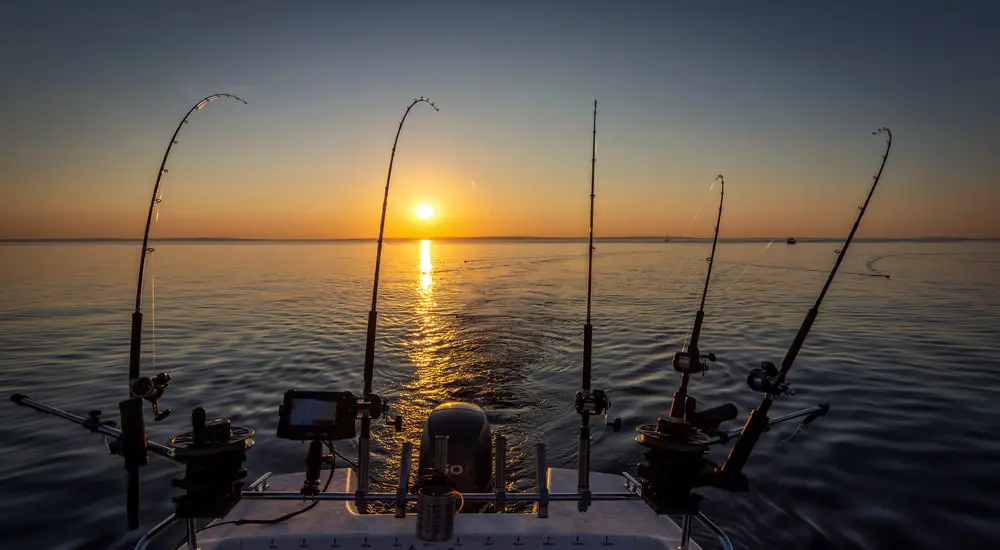
Trolling for Salmon involves more than simply dragging multiple lines behind the boat. Understanding the right techniques and strategies will significantly enhance the chances of success. Here are some key factors to consider:
Trolling Speed For Salmon
Maintaining the right speed is crucial since certain salmon species have a speed preference for their moving prey and also because some lures do not work well at certain speeds.
Typically, the ideal trolling speed for salmon is 2 to 3 miles per hour (mph).
I use a GPS or a speedometer specifically designed for trolling to monitor my speed accurately. I adjust my speed based on the fishing conditions, the behavior of the fish, and the type of lure or bait I am using.
- King Salmon Trolling Speed – 2.0 to 3.0 miles per hour
- Coho Salmon Trolling Speed – 3.0 to 5 miles per hour
- Pink and Chum Salmon Trolling Speed – 2.0 to 3.0 miles per hour
- Atlantic Salmon – 1.5 to 3 MPH
- Landlocked Salmon Trolling Speed – 1.0 to 2.5 miles per hour
- Downrigger Trolling speed – 1.5 to 3.5 MPH
- Dipsy Diver Trolling Speed – 2.5 to 3.0 MPH
- Lead Core Line Trolling Speed – 1.0 to 2.5 MPH
Guide Tip: It’s common for a salmon to follow the lure or bait for a long time. Experienced guides will sometimes slow down and then speed up to trigger more salmon to bite. Instead of driving the boat in a straight line, drive in an “S” pattern which slows and speeds up the lures.
My lures and flashes need to be working properly. Flashers should spin in wide circles, and lures should wobble, flutter, and vibrate.
To ensure the lure is working properly, lower the rig just below the surface while at the desired speed and look to see that everything is running right. Adjust speed as needed.
Depth Control
The depth at which I present my bait or lure plays a vital role in enticing Salmon. Downriggers are incredibly useful for controlling the depth of the salmon rigs. Find the salmon or the bait fish on the sonar unit and lower the downrigger ball 5 to 10 feet above the salmon.
Adjust the depth based on factors like water temperature, the presence of bait fish, and the known depth preferences of the Salmon species I am targeting. If you don’t have downriggers, you can use diving planers or lead-core lines to achieve the desired depth.
Line Spacing and Spread
When trolling with multiple lines, it’s crucial to maintain proper line spacing and spread both across and in different parts of the water column. This prevents tangles and allows my lures or baits to cover a wider area.
A general rule of thumb is to space the lines at least 30 feet apart. Use planer boards or specialized trolling releases to spread out the lines horizontally increasing the coverage area. Adjust the line spacing and the spread based on the water clarity and the number of lines I can effectively manage, as well as what is legal.
Pay Attention to Structure
Salmon are often fished out in open water around schools of baitfish, however, at times, and provide the right conditions, salmon can also be found near underwater structures, such as drop-offs, reefs, and rocky outcrops.
By trolling along these structures, I increase the chances of encountering actively feeding Salmon.
Use a fishfinder, GPS, or chart plotter to locate underwater structures and plan my trolling route accordingly.
Vary The Presentation
Experimentation is key when it comes to successful salmon trolling. Try different lure colors, sizes, and styles to determine what the fish are most responsive to on a particular day.
Pay attention to the water conditions, such as clarity and light penetration, and choose lures that stand out or mimic the natural prey of the Salmon.
Adjusting my presentation by varying the distance behind the boat, the trolling depth, and the action of the lure. Sometimes, a subtle change in presentation can trigger a strike from a hesitant Salmon.
Top Trolling Spots For Salmon
Now that you’re equipped with the necessary knowledge and techniques, it’s time to explore some of the top trolling destinations for Salmon. While Salmon can be found in various waterbodies around the world, we’ll highlight a few renowned locations known for their exceptional trolling opportunities:
- Pacific Northwest, United States: The rivers and coastal areas of the Pacific Northwest, particularly in Washington and Oregon, offer fantastic trolling for Chinook, Coho, and other Salmon species. Explore renowned spots like the Columbia River, Puget Sound, and the Strait of Juan de Fuca for thrilling Salmon action.
- British Columbia, Canada: British Columbia is famous for its pristine rivers, lakes, and coastal waters that teem with Salmon. Trolling enthusiasts flock to locations like the Fraser River, Queen Charlotte Islands, and Haida Gwaii for epic Salmon fishing experiences.
- Alaska, United States: Alaska is synonymous with Salmon fishing, and it boasts some of the most incredible trolling opportunities in the world. From the renowned Kenai River to the remote wilderness of Bristol Bay, Alaska offers a vast playground for Salmon anglers. Target species like the massive king salmon, feisty Coho Salmon, and abundant Pink Salmon in this angler’s paradise.
- Scotland, United Kingdom: Scotland’s lochs and rivers provide an excellent backdrop for trolling Salmon. The famous River Tweed, River Tay, and Loch Lomond are known for their Salmon populations and attract anglers from around the globe. Experience the beauty of the Scottish Highlands while trolling for Atlantic Salmon.
- Norway: Norway’s rivers and fjords are home to thriving populations of Atlantic Salmon. Troll along the storied waters of the Gaula River, Orkla River, or the breathtaking fjords of northern Norway for a chance to hook into a powerful Atlantic Salmon.
- Kamchatka Peninsula, Russia: Remote and virtually untouched, the Kamchatka Peninsula in Russia offers exceptional trolling opportunities for Pacific Salmon. Explore the Kamchatka River, Zhupanova River, and other pristine waters to target trophy-sized Chinook, Coho, and other Salmon species.
- Great Lakes: Anglers have the opportunity to catch all five major salmon and trout species in a single trip: coho salmon, king salmon, lake trout, steelhead, and brown trout. Recent stocking has also created an opportunity for Atlantic salmon.
Remember, these are just a few examples of the countless trolling destinations available for Salmon fishing.
Research your desired location, consult local guides or fishing charters, and plan your trip accordingly. Each region has its own unique fishing regulations, so make sure to familiarize yourself with the rules and obtain the necessary permits or licenses.
Trolling For Great Lakes Salmon
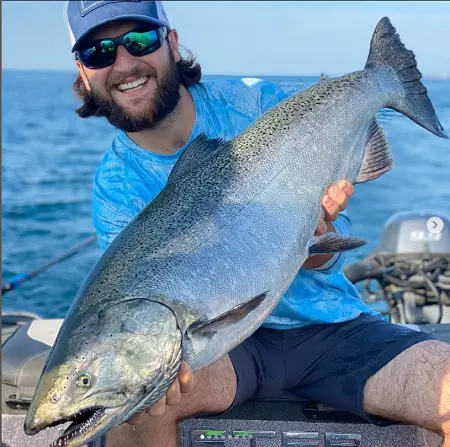
Did you know that the Great Lakes region of North America has some of the best salmon fishing in the world despite it being freshwater only?
May is a fantastic month for salmon and trout fishing on Lake Michigan, particularly in the Indiana and Illinois waters. Lake Ontario is another hot spot for huge Great Lakes salmon, including recently introduced Atlantic salmon.
Lake Huron, Georgian Bay, and Lake Superior all have decent salmon trolling opportunities.
Don’t forget to check out our article: Lake Michigan Salmon Fishing.
Anglers have the opportunity to catch all five major salmon and trout species in a single trip: coho salmon, chinook salmon, lake trout, steelhead, and brown trout. As the water temperatures warm up, the fish move offshore, and trolling in deeper waters becomes necessary.
Successful anglers need to adapt to the changing conditions and follow the fish. However, they can still focus on areas relatively close to the productive spots in April. Fishing reports from charter boat operators and local fishermen are invaluable for tracking fish movements and finding the best locations.
Trolling in offshore waters requires specific tactics and gear. Surface lines are a good starting point, with coho salmon and steelhead often found near the top layer of water. Planer boards are useful for deploying multiple shallow-running lures on each side of the boat, expanding the trolling spread and increasing the chances of catching fish.
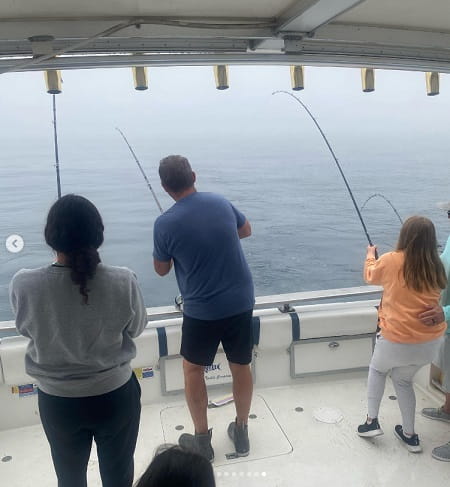
To target salmon in deep water, downriggers are essential. Adjusting the depths and experimenting with settings can help determine the most productive levels for each species.
Fishing near the middle of the water column often yields good results, with coho salmon being the primary catch.
The lower edge of the water column, including the lake bottom, can be targeted with downriggers set closer to the surface and lures bouncing along the bottom, ideal for lake trout.
Lure selection plays a crucial role in attracting salmon and trout. Crankbaits, dodger-and-fly combinations or flasher-and-fly combinations, and thin trolling spoons are popular choices. These lures mimic the preferred prey of the fish and can be used at different depths to optimize the trolling spread. See Best Trolling Spoons For Salmon.
Guide Tip: Use salmon trolling spoons on the riggers and flasher/flies on the dipsy divers or flasher cut-bait on the dipsy
Cut Bait and Whole Herring Rigs: Fishing bait like a cut-herring or whole herring behind a flasher is a great way to catch salmon. See these videos: How to rig a Cut Plug Herring for Salmon Fishing and How to rig a full herring for king salmon fishing.
May is a prime time for multi-species salmon and trout fishing on Lake Michigan. By utilizing planer boards, adapting to changing conditions, and selecting the right lures, anglers can maximize their chances of success and enjoy an exciting fishing experience on the lake. Stay informed through fishing reports and be ready to follow the fish for a rewarding fishing trip.
Tight Lines,
Graham
